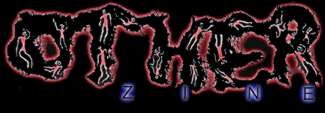
Man Ray's L'etoile De Mer: A Philosophical Reading
by James M. Magrini
(Click here for printer-friendly version)
"Magic rites, primitive civilizations, alchemy, the language of flowers, fire, or sleepless nights, are so many stages on the way to unity and the philosophers' stone." Albert Camus
Introduction
The basic human drive toward the union of antipodal extremes is depicted as a quest for reconciliation in the 1928 Surrealist film, L' etoile de Mer (The Star of the Sea) . Couched in alchemical and occult symbolism, the theme is revealed within the allegorical narrative as the desire for unity and truth in a world turned upside down by the "war to end all wars". In the aftermath of World War I, death and destruction had overrun Europe rendering the pontifications of Western intellectualism absurd at best.
Although fundamentally linked with the Dada movement, an intense sensibility exists within most Surrealist work. They sought to examine being anew by looking beyond "rationalism" and stripping away the anthropomorphic prejudice that had for centuries obscured mankind's vision of authentic truth. Aesthetic expression, it was determined, held the capacity to provide access into a mystically transfigured and perfected world; a realm of unified opposites that Appolinaire joyfully christened "Surreality".
I. The Surreal Dialectic
Aspiring to an existence far superior to that of ordinary reality the Surrealists embraced the thoroughly "modern mystery" of cinema as a means to bypass rationality and comprehend truth which had heretofore been distorted by the trappings of linguistics. Film as an aesthetic medium of expression was thought more advanced than either poetry or the plastic arts. Because of its powerful visceral imagery and the immediacy of its effect it allowed instantaneous and direct access to the viewer's unconscious without entirely precluding consciousness and, as opposed to knowledge imparted through abstract conceptualization, its truths were passed along "intuitively".
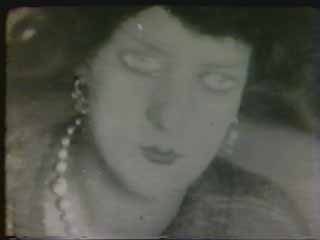 The
Surreal cinematic experience was unique
in cultivating the spectator's involvement,
yet allowing the "consciousness of
fiction" to remain operative; this
is a belief in the authenticity of
the images and the simultaneous realization
of their status as illusionary. This
produces within the viewer a phenomenon
of what may be termed the condition
of "dreamlike wakefulness." Within
this semi-hypnotic psychic state the
associative processes of the mind
function without the traditional structures
of symbolization. Any time perceptual
transference remains unimpeded; meaning
is produced independently of the logical
constructs of oral or written communication
and the viewer is profoundly touched
and enlightened without recourse to
the discursive entanglements of traditional
rationality.
The
Surreal cinematic experience was unique
in cultivating the spectator's involvement,
yet allowing the "consciousness of
fiction" to remain operative; this
is a belief in the authenticity of
the images and the simultaneous realization
of their status as illusionary. This
produces within the viewer a phenomenon
of what may be termed the condition
of "dreamlike wakefulness." Within
this semi-hypnotic psychic state the
associative processes of the mind
function without the traditional structures
of symbolization. Any time perceptual
transference remains unimpeded; meaning
is produced independently of the logical
constructs of oral or written communication
and the viewer is profoundly touched
and enlightened without recourse to
the discursive entanglements of traditional
rationality.
Despite their revulsion for traditional intellectual activity, the Surrealists initiated, albeit in aesthetic terms, what amounts to nothing less than a philosophical inquiry into the nature, structure, and organization of the universe. They hypothesized that objective reality stood in an extreme and dichotomous relationship to genuine existence or "Surreality," which was in turn mediated and falsified by the process of human conceptualization. The tri-fold metaphysical schema proposed by the artists must be acknowledged before a philosophical reading of the film is conceivable and runs thus: (1) Objective reality (raw sensory stimuli), (2) phenomenal reality (world of appearances plus conceptualization), and (3) Thing-behind-appearances (Universal Surreal Truth).
Objective reality was envisaged as a mass of perceptual input constantly in a state of flux and transition, which required conceptualized structure to be made intelligible. Beyond objective and phenomenal reality an essence or universal thing-behind-appearances (Surreality) was present and characterized the timeless essence or foundation of all being. Phenomenal existence had no relation whatever to universal truth and separated objective reality from "Surreality." Therefore, to experience an all-embracing truth the barricade comprised of reason, rationality, and ordered social existence required circumvention. When this was accomplished, through aesthetic activity or by way of the philosopher's stone, a clash of opposites or two extremes of reality occur and the experience produces within perceptual or "intuitive" understanding a momentary intimation of authentic "Surreality".
Avant-garde cinema shunned traditional or commercial cinema, which was modeled on the great Aristotelian "triangle" of the Western literary arts. Meaning here develops and is expressed within a succession of tightly ordered dramatic situations. Man Ray relied on characterization, optical reality, and narratives only as a means or ploy for which to involve the viewer in the world of the film. The cinematic apparatus, as stated by Rudolf Kuenzli, was "used by the Surrealist filmmakers as a powerful means to realistically portray the symbolic [traditional] order, which they then disrupt[ed] with shocking, terrifying images."1 Specifically utilized as a foundation from which to create a new perspective of seeing reality, this cinematic tendency is no doubt at work within L'etoile de Mer.
The film's male protagonist (L' homme) is at once alchemist, philosopher, and artist. He sets out in search of the woman (La Femme) who must be assimilated if the true nature of his being, along with ultimate potentiality, is to be realized. This proposed unification of dichotomous elements imply a yearning for a state of existence, which is at once male and female within a single, definitive figure. In this and every other surreal instance "the two extremes must be reconciled in order for either one to fulfill, however briefly, its own nature."2 The components of the philosophical dialectic are unmistakable: thesis, antithesis, and synthesis.
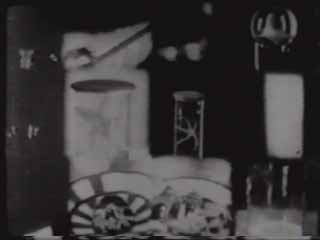 Enclosed
in glass and suspended in a formless,
colorless liquid, the starfish is
the desired end of the alchemist's
ritual of transformation that consummates
in an androgynous hermaphroditic fusion.
It as well may be viewed as universal
truth at the culmination of the philosopher's
quest, and, finally, the Surrealistic
Aesthetic and psychic unification
of both the conscious and unconscious.
This integration of elements was foremost
to the alchemist's experimentation
and Carl Jung in Dream Symbolism in
Relation to Alchemy documents the
proposed interconnectedness of psychology,
alchemy, and the occult.
Enclosed
in glass and suspended in a formless,
colorless liquid, the starfish is
the desired end of the alchemist's
ritual of transformation that consummates
in an androgynous hermaphroditic fusion.
It as well may be viewed as universal
truth at the culmination of the philosopher's
quest, and, finally, the Surrealistic
Aesthetic and psychic unification
of both the conscious and unconscious.
This integration of elements was foremost
to the alchemist's experimentation
and Carl Jung in Dream Symbolism in
Relation to Alchemy documents the
proposed interconnectedness of psychology,
alchemy, and the occult.
Although conceived and executed aesthetically, this truth-seeking venture was dedicated to usurping and supplanting venerable ideas of world structure and thus philosophical through and through. Danger exists when the parameters of knowledge are stressed to the limit. The volatile tension and friction created by the forced unification of opposites, forever battling to strain apart, is experienced as the discontinuity and tension, inherent in all Surreal work, threatens to rent the entire film before the viewer's eyes. The viewer unnervingly observes camera shots of the fast moving train along tracks, the quivering mechanical fade-outs, dissolves, superimpositions, panning as newspapers blow about the street, split-screen effects with the repetition of spiraling starfish in glass receptacles all adding a curious and disturbing energy to the presentation. However, the most obvious expression of oppositional antagonism between the polar extremities of the philosophical dialectic is Man Ray's technical use of the gelatin-filtered lens.
II. The Use of the Camera
Man Ray mirrors the idea of social convention and rationalism forming a bulwark between mankind and knowledge of the truth or a purely aesthetic mode of existence within the juxtaposition of filtered and unfiltered camera shots. This cinematic practice assumes more significance now that the philosophical dialectic along with alchemical and occult iconography is understood. I am suggesting a reading where the filtered shots are representative of phenomenal reality from which the artists sought dissociation while the implementation of the unfiltered lens corresponds to the idea of "Surreal" existence which has been transfigured by the intervention of aesthetic activity.
The opposition between the two dichotomous aspects of being explicitly manifest amid various shots of the man, woman, and starfish. The narrative and progressive action, when distorted in a gelatinous haze, categorically places the male and female at the mid-ground of dialectic methodology and within the initial phases of alchemical metamorphosis. While social mores, education, and flawed intellectualism continue to obscure pure and unimpeded vision of authentic universal truth, the characters demonstrate a heightened state of awareness; the on-the-wayness of philosophical inquiry and commence what will ultimately prove a hazardous undertaking.3
The truth-seeker sets out to cross a raging, torrential sea with the unyielding objective to unify contrasting elements. The unfiltered shots offer to us Man Ray's vision, and more than this the "Surreal" vision, into the reconciliation of opposites within the elements of androgyny. The filmmaker delineates unequivocally the path to the starfish, which is at once the male's surreal quest and, as pentacle of the tarot, a beacon and mystical symbol of hope. We estimate the artist has wiped clean perception and suggests to us a visual brilliance that can only be equated with a momentary impression of immutable, eternal truth. The barrier of rational and conventional prejudice has been momentarily surmounted. This becomes obvious when analyzing the various shots of the starfish and by devoting particular attention to three integral shots of the female. Whenever the starfish is present to the film whether in glass cylinder, aquarium, as part of still life with wine and fruit, or beneath the text upon which the woman places her foot the camera lens is unrestricted.
In projecting a universal vision, Man Ray selects occult and alchemical symbolism with the resolve to elicit the unconscious workings of the psyche. Jungian dream analysis informs us that symbols cannot be known immediately or decisively comprehended; instead they are like archetypes buried deep within the collective unconscious. We observe within L' Etoile de Mer two essential aspects of the symbol and its inner workings. Both retrospective symbol analysis and prospective symbol analysis are present. The former is directed by the instinct, libido, and base drives of all sorts, while the latter represents mankind's longing for completion, unification, harmony, and concern for future destiny [potentiality].4
This psychological process of symbol divination speaks volumes concerning the nature, power, and import of the shared "collective" aesthetic experience. The artist and spectator activate and flesh-out the meaning of these symbols which lay incomplete and dormant, much like negative images within the psyche requiring individual experience via conscious and unconscious activity to fully expose. "Artistic creation is thus a concentrated personal experience of 'Surreality' for artist and spectator."5 The process includes: (1) the artist's perception of "Surreality" as expressed within the film, and, (2) the reconciliation with his audience through the art, so that Man Ray's Surreal vision is at once "mutual and simultaneous." One might imagine the ancient tragic performances where at once artist and spectator, lost in a rapturous intoxicated Dionysian frenzy, were reciprocally transformed. Instead of occurring at the ancient Hellenic Theater at Epidaurus however, the experience transpired within the modern movie-houses and salons of the Surrealists.
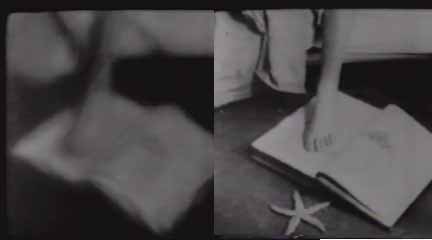 As
both male and female journey into
"Surreality" the dialectic process
transpires in three distinct phases
which indicate the critical transitions
that accompany change or human aetiology.
Initiation into many of the ancient
world's cult or mystery religions
(e.g., Orphism, Cult of Eleusis) develops
and advances in a similar pattern
of dialectic function. Demarcating
the faces that mark all rites-of-passage:
Separation, Marginality, and Aggregation,
I choose three paradigmatic scenes
to serve as illustration. The first
in the series documents the woman's
awareness of separation and acknowledgment
of what must be suffered. As she steps
from the bed and places her foot down
on what appears to be an open book
the translucence of the gelatin filter
cryptically shrouds her action. All
at once, the screen fades to black
and with no change of angle the lens
opens to promptly reveal a modified
setting. The filter has now been removed
and a transformed viewpoint marks
the female's departure or detachment
from a previous state of existence
and includes the starfish, which has
mystically appeared below what we
can now make out to be an alchemist's
handbook of magic.
As
both male and female journey into
"Surreality" the dialectic process
transpires in three distinct phases
which indicate the critical transitions
that accompany change or human aetiology.
Initiation into many of the ancient
world's cult or mystery religions
(e.g., Orphism, Cult of Eleusis) develops
and advances in a similar pattern
of dialectic function. Demarcating
the faces that mark all rites-of-passage:
Separation, Marginality, and Aggregation,
I choose three paradigmatic scenes
to serve as illustration. The first
in the series documents the woman's
awareness of separation and acknowledgment
of what must be suffered. As she steps
from the bed and places her foot down
on what appears to be an open book
the translucence of the gelatin filter
cryptically shrouds her action. All
at once, the screen fades to black
and with no change of angle the lens
opens to promptly reveal a modified
setting. The filter has now been removed
and a transformed viewpoint marks
the female's departure or detachment
from a previous state of existence
and includes the starfish, which has
mystically appeared below what we
can now make out to be an alchemist's
handbook of magic.
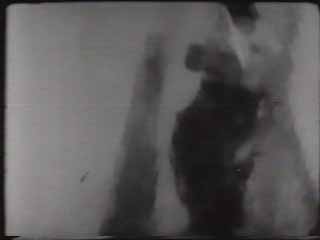 The
second episode occurs during the final
scenes and again commences from behind
the optically twisted vantage point
of the filtered camera lens. The woman
moves up the stairs to the same bedroom
that she and the male had earlier
departed from. A dagger is clutched
in her hand (the sword of the tarot)
as if marking her entry into a state
of living in the margins. La Femme
is poised on the shadowy periphery
of total aggregation. A portentous
foreboding begs the viewer's questioning:
Will she perform a sacrificial ritual
or will she be ceremoniously sacrificed
to the higher ideal? A sense of ambiguity
looms as the camera cuts to pan the
stairs she is ascending and we notice
the filter has once more been removed.
The lens momentarily freezes on the
starfish positioned on the carpeted
step and then, as she continues up
to the room, presumably to cross over
into a state of perfected being, the
filter is cleverly reengaged.
The
second episode occurs during the final
scenes and again commences from behind
the optically twisted vantage point
of the filtered camera lens. The woman
moves up the stairs to the same bedroom
that she and the male had earlier
departed from. A dagger is clutched
in her hand (the sword of the tarot)
as if marking her entry into a state
of living in the margins. La Femme
is poised on the shadowy periphery
of total aggregation. A portentous
foreboding begs the viewer's questioning:
Will she perform a sacrificial ritual
or will she be ceremoniously sacrificed
to the higher ideal? A sense of ambiguity
looms as the camera cuts to pan the
stairs she is ascending and we notice
the filter has once more been removed.
The lens momentarily freezes on the
starfish positioned on the carpeted
step and then, as she continues up
to the room, presumably to cross over
into a state of perfected being, the
filter is cleverly reengaged.
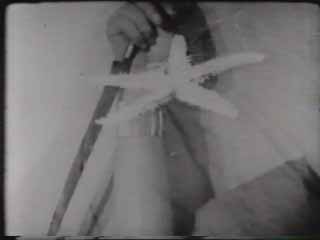 The
final shot records the "synthesis"
of the dialectic process or aggregation
of alchemical sacrament. The conflict
of opposites has successfully been
resolved. She lies consummate on the
bed with the dagger in her grip with
starfish superimposed indicating her
metaphorical death to old sensibilities
and rebirth of spirit in the collective
persona of the masculine and feminine.
A violent breaking down of elements
has occurred and she has now been
reassembled in a new manner. The montage
assumes an otherworldly quality as
the starfish wavers and hovers above
her head, torso and hand with dagger.
Within this series of progressive
imitations, meaningful symbolizations,
and utilization of cinematic technique,
Man Ray has established the Surrealists'
metaphysics through the use of dialectic
methodology.
The
final shot records the "synthesis"
of the dialectic process or aggregation
of alchemical sacrament. The conflict
of opposites has successfully been
resolved. She lies consummate on the
bed with the dagger in her grip with
starfish superimposed indicating her
metaphorical death to old sensibilities
and rebirth of spirit in the collective
persona of the masculine and feminine.
A violent breaking down of elements
has occurred and she has now been
reassembled in a new manner. The montage
assumes an otherworldly quality as
the starfish wavers and hovers above
her head, torso and hand with dagger.
Within this series of progressive
imitations, meaningful symbolizations,
and utilization of cinematic technique,
Man Ray has established the Surrealists'
metaphysics through the use of dialectic
methodology.
James Magrini
August 30, 2001
Quotations and Notes
1. Rudolf E. Kuenzli
from Dada and Surreal Film
2 Matthew Gale from Dada and Surreal
Art
3. Karl Jaspers from The Way to Wisdom
4. Carl Jung from "Dream Symbolism
in Relation to Alchemy," (within Viking's
Portable Jung).
5.
Mathew Gale from Dada and Surreal
Art